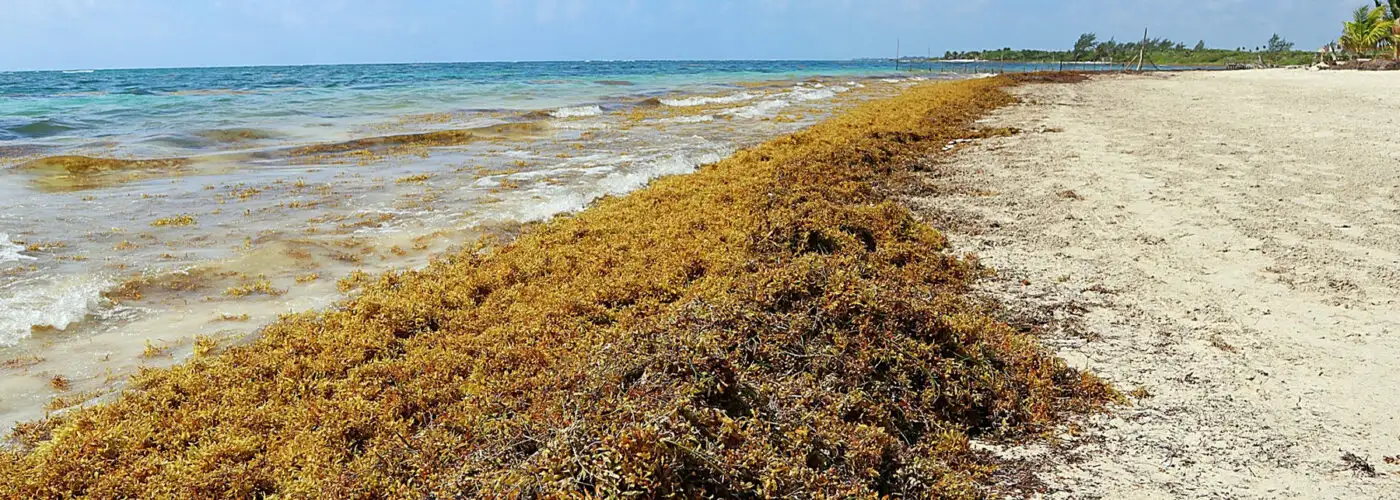Beachgoers are accustomed to finding small clumps of seaweed scattered around the sand or amongst the waves. But lately, visitors to beaches in the Caribbean, Mexico, and Florida might be surprised to be swimming in far more seaweed than they hoped for on their summer vacation: Sargassum.
The common brown seaweed has exploded in recent years; sargassum now washes up in huge piles on coastlines in the Gulf of Mexico and the Caribbean, especially in the warmest months of the year. And while stepping through massive deposits of slippery oceanic vegetation might be only a minor nuisance to some, there’s another issue: Sargassum smells bad, reportedly like rotten eggs. It turns the water a murky, unpleasant shade of brown, and has been reported to have stretched across the entire Atlantic Ocean, from the African coast to the Gulf of Mexico, at its peak.
Tourists, of course, don’t come to tropical beaches to wade through waves choked with smelly seaweed, so resorts and other beachfront travel providers have taken up the effort of removing it. The total cost of removing sargassum from beaches in the Caribbean was estimated to be $120 million in 2018, and there’s no indication that the sargassum onslaught will abate any time soon.
What Fuels Sargassum?
The sargassum bloom seems to stem from two linked factors, according to Phys.org: Climate change, and the increased deforestation of the Amazon. Sargassum prefers warmer water, so even small increases in water temperature can fuel increased growth. In short, Earth’s warming oceans are creating better conditions for sargassum, and the seaweed is proliferating accordingly.
However, scientists believe deforestation in the Amazon is juicing those conditions. Land along the river has been aggressively cleared for farming over the past half-decade, but (ironically, and tragically) the soil there is poor, forcing farmers to use substantial amounts of fertilizer. Some of this fertilizer washes into the river and eventually the Atlantic Ocean, where it feeds the growing sargassum blooms. Satellite imagery shows large patches of sargassum at the mouth of the Amazon, from which it spreads across the Atlantic, to form a 5,592 mile-long mass of seaweed called the Great Atlantic Sargassum Belt (GASB).
Between the sheer mount of sargassum already in the ocean and the seeming implacability of the conditions causing it, scientists worry we’ll just have to get used to having the stuff on our beaches.
“We think this is going to be the new normal,” Steve Leatherman, aka Dr. Beach, told Phys.org, “so we are going to have to find a way to deal with this, and it’s going to be difficult,”
Readers: How would you feel if you showed up to a beach resort, only to find the beach covered in smelly seaweed? Comment below.
More from SmarterTravel:
- 11 Endangered Bucket List Destinations, and How to Visit Them Responsibly
- What Your Sunscreen Is Doing to the Environment
- 7 Things You Should Never Do in the Caribbean
We hand-pick everything we recommend and select items through testing and reviews. Some products are sent to us free of charge with no incentive to offer a favorable review. We offer our unbiased opinions and do not accept compensation to review products. All items are in stock and prices are accurate at the time of publication. If you buy something through our links, we may earn a commission.
Related
Top Fares From
Today's Top Travel Deals
Brought to you by ShermansTravel
Shop and Save with Country Inns...
Patricia Magaña
 Hotel & Lodging Deals
Hotel & Lodging Deals
$229 -- Chicago: Discounted Rates and...
Francesca Miele
 Hotel & Lodging Deals
$229+
Hotel & Lodging Deals
$229+
$188 -- Honolulu: Save on Oceanview...
Abigail Lamay
 Hotel & Lodging Deals
$188+
Hotel & Lodging Deals
$188+




